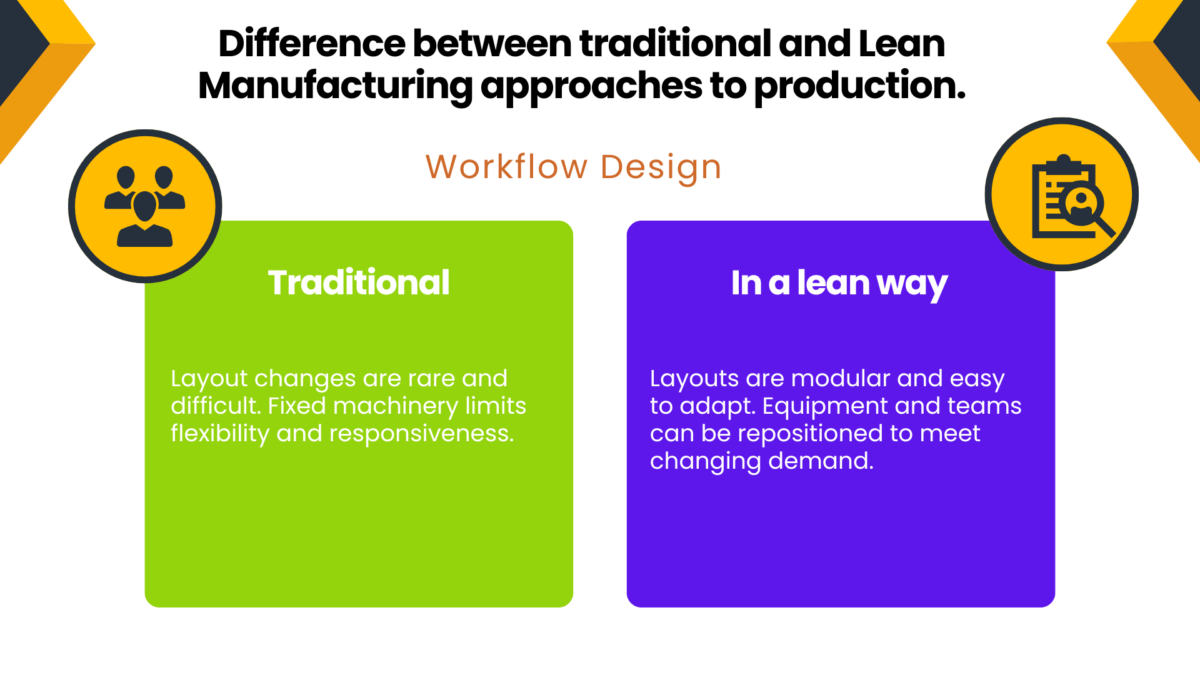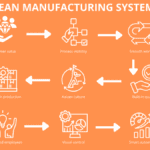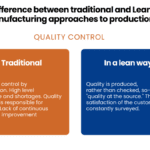
Spis treści
In the ever-evolving world of operational excellence, two things remain constant: waste is the enemy, and continuous improvement is the path forward. This article is a comprehensive resource and guide to lean principles and methodology, offering insights for beginners and experienced practitioners alike. The base of lean lies in foundational practices such as standardized work, visual management, and respect for people, which support ongoing improvement and waste reduction. The term ‘Lean’ is not an acronym; it was coined by Womack and Jones after observing Japanese management practices, particularly at Toyota, to describe an approach focused on waste reduction and operational excellence. Lean principles were brought into manufacturing and later adopted by other industries to improve efficiency and eliminate waste. This adoption fundamentally changed industries, as highlighted in works like ‘The Machine That Changed the World,’ marking a significant transformation in organizations’ operations. When we talk about “lean and lean,” we refer not just to the theoretical frameworks of lean manufacturing or management, but to a mindset and culture that encompasses every layer of a lean organization. From the shop floor to top-level management, adopting lean principles is no longer optional—it’s necessary to remain competitive, deliver customer value, and create agile, responsive systems.
But how do you instill these concepts into a workforce resistant to change? Implementing lean process improvement is a complex and multifaceted challenge, requiring continuous identification, implementation, and measurement of improvements. How do you make the leap from theory to fundamental transformation? The answer lies in how you train your team—and more specifically, in applying practical, interactive learning methods that engage every team member. This is where simulation-based learning, like the GET LEAN game, becomes a game-changer.
Introduction to Lean
Lean is more than just a set of tools—it’s a management philosophy that delivers high-quality products and services while minimizing waste and maximizing customer value. Lean has become a leading approach in manufacturing and beyond, drawing on the Toyota Production System, transforming industries such as healthcare, software, and government. The core concept of Lean is continuous improvement, where teams work together to identify inefficiencies, implement changes, and drive ongoing improvement. Organizations can reduce costs, improve quality, and boost customer satisfaction by implementing Lean principles. This focus on improvement and teamwork leads to higher profits and helps businesses stay competitive in today’s fast-paced market. Lean offers a proven path to delivering what your customers truly value, whether in manufacturing or service.
The Challenge: Turning Theory Into Action

Organizations often begin their lean journey with high hopes, investing in workshops, whitepapers, and online courses. While these have their place, they usually fail to drive lasting change. Why? Because lean practices must be lived and experienced. Employees must actively identify waste, improve flow, and understand the value stream from the end customer’s perspective.
To make lean effective, it is essential to break down processes into specific steps to improve efficiency and eliminate waste. Making incremental improvements daily is vital to fostering a culture of continuous improvement. Teams should regularly identify what is holding up workflow progress and address these obstacles promptly. Each individual must evaluate and improve processes to ensure alignment with organizational goals. Without hands-on experience, terms like pull system, process flow, or zero waste remain abstract. That’s why training in lean manufacturing should take a comprehensive approach, combining theory with real-time exercises, simulations, and interactive lean tools.
Lean Principles: The Foundation of Lean Thinking
As outlined by Womack and Jones, the five principles of Lean form the essential foundation for any Lean transformation. These principles guide organizations in creating processes that consistently deliver value to customers. The journey begins with defining value—understanding exactly what customers want and are willing to pay for. Next, mapping the value stream allows teams to visualize every step in the production process, making it easier to spot and eliminate waste. Creating flow is the third principle, focused on ensuring that work moves smoothly and efficiently through each stage, without unnecessary delays or bottlenecks. The fourth principle, using a pull system, means producing only what is needed, when it is required, which helps reduce excess inventory and costs. Finally, pursuing perfection encourages organizations to continuously seek improvement, striving for flawless processes and maximum customer satisfaction. By embracing these five principles of Lean, companies can build a culture of improvement and deliver better customer results.
The Solution: Lean Simulation as a Training Strategy

One of the most effective ways to train your workforce is through a lean simulation game. Among the most impactful tools available today is the GET LEAN Simulation Game. Designed to bring lean thinking to life, this game helps participants create flow, identify bottlenecks, and improve processes through a multi-round format that mimics real-world production. The simulation effectively brings value and quality to participants and stakeholders by aligning activities with customer needs and ensuring continuous value addition. It also helps participants define and align with the goal of lean transformation, focusing on solving customer problems and achieving organizational success.
Unlike traditional lectures, the GET LEAN game:
- Engages all employees by placing them in realistic production system scenarios.
- Encourages simple innovations and team-driven problem-solving.
- Teaches the Toyota Production System philosophy through practical application.
- Helps players understand the importance of value delivery, customer satisfaction, and inventory control.
- Demonstrates how value is delivered to customers or stakeholders by tracking outputs and measuring process effectiveness.
- Reinforces lean practices such as stream mapping, pull flow, and continuous waste reduction.
- Shows how ongoing enhancements can improve processes, leading to greater efficiency and reduced waste.
- Illustrates the integration of Lean and Six Sigma methodologies, demonstrating how this approach leads to sustainable process improvement.
- Teaches leveling by balancing workloads and ensuring smooth process flow across teams and steps.
- Encourages the spread of lean knowledge and best practices throughout the organization, supporting a culture of continuous learning.
- Provides real-life learning experiences for students who have successfully applied lean concepts gained from the simulation.
What Makes GET LEAN Unique?

The GET LEAN Simulation Game stands out because it’s designed to train across departments—not just manufacturing but logistics, service, and supply chain functions. It supports a comprehensive approach to training by focusing on:
- Development of both technical and interpersonal skills
- Practice with real metrics in a safe environment
- Streamlined implementation of tested lean tactics
- Teamwork and shared responsibility in driving improvements
- Efficient use of resources to maximize value and minimize waste
- The importance of keeping teams stable for knowledge retention and continuity, as well as keeping only necessary inventory on hand
- Demonstrating the negative impact of excess products being stored in inventory, which can reduce efficiency and increase costs
GET LEAN comprises six distinct rounds, each building on the lessons from the previous rounds. From chaotic, unstructured systems to highly optimized lean processes, participants experience firsthand how to transition from firefighting to structured, proactive planning.
👉 Discover the whole game experience here: GET LEAN Simulation Game
Why Practical Lean Training Matters
Many companies claim they are on a lean journey, but without a solid training program, lean and lean remain buzzwords. Here’s why practical simulation-based learning matters:
- It engages the entire organization, from line workers to senior managers.
- It bridges the gap between theory and reality using process-based thinking.
- It reinforces the idea that minor improvements create a ripple effect across the entire organization.
- It cultivates a mindset of continuous development and operational excellence.
- It helps reduce costs by eliminating waste and improving efficiency.
- Lean principles matter for all organizations, regardless of industry or size.
- Understanding price from the customer’s perspective is crucial to deliver real value.
The Role of Continuous Improvement
Continuous improvement is at the heart of Lean thinking, driving organizations to constantly seek better ways to operate. This approach is about learning, experimenting, and making incremental changes that add to significant progress over time. Teams are encouraged to regularly review their performance, especially during key periods like July, when many organizations assess their progress and set new goals. Using data and metrics to track improvement, teams can identify what’s working and where further changes are needed. This ongoing review process helps build a culture of trust, accountability, and shared responsibility, empowering every team member to contribute to the organization’s success. Continuous improvement helps organizations respond to challenges and ensures they are always moving forward, building stronger teams, and delivering greater customer value.
Combine Theory with Practice Through Our Training Packages
At Sabat Consulting, we offer more than just games—we deliver complete training solutions that integrate theory, practice, and measurable results. Our lean management training courses cover the history, core principles, and application of the lean process as a continuous improvement methodology. They combine:
- Expert-led lessons on lean principles and value stream mapping
- In-depth modules on process optimization, lean thinking, and Six Sigma techniques
- Access to the GET LEAN game and a complete simulation training package
These are ideal for:
- Companies launching lean initiatives
- Organizations seeking manufacturing excellence
- Teams focused on reducing costs, eliminating waste, and optimizing customer service
👉 View our course offerings: Lean Training Courses – Sabat Consulting
Measuring Success: How to Know Lean is Working
Knowing whether Lean is making a difference in your organization comes down to measuring the right things. Key metrics such as lead time, cycle time, throughput, and customer satisfaction provide valuable data on how Lean is improving processes and delivering better results. For example, a decrease in lead time shows that your team is working more efficiently, while higher customer satisfaction scores indicate that you provide more value. Lean expert Kim emphasizes that true success isn’t just about the numbers—it’s about understanding how Lean is helping your organization and its customers thrive. Combining complex data with customer and team member feedback gives you a complete picture of your progress. Today, organizations implementing Lean are seeing real improvements in quality, reduced costs, and enhanced services, proving that Lean delivers lasting benefits for businesses and their customers.
The Legacy of Lean Manufacturing: From Henry Ford to the Future
The roots of lean thinking trace back to Henry Ford, whose production flow and standardization innovations laid the groundwork for the lean enterprise movement. Unlike the rigid, inflexible systems of the past, lean methodologies emphasize flexibility and adaptability, enabling organizations to respond quickly to change. Today, leading organizations worldwide—guided by the Lean Enterprise Institute, the Toyota Production System, and local experts—continue to refine and implement lean management to stay ahead.
Training your team in these principles, primarily through games like GET LEAN, is not just a best practice; it is a necessity. It’s an investment in your company’s future.
Final Thoughts: Lean and Lean – From Efficient Thinking to Lean Leadership
Training today’s teams requires more than just delivering content. To be truly effective, Lean and lean must go hand in hand—lean as in doing more with less, and Lean as in building a culture of purpose, flow, and continuous improvement.
Lean games and simulations make this connection real. They bring Lean principles to life by letting teams experience problems, test solutions, and see results in a fast-paced, hands-on environment. It’s not just theory—it’s Lean in action.
Whether you’re looking to spark improvement, launch a transformation, or support existing Lean initiatives, simulation-based training is the most practical way to:
✅ Train Lean skills with impact
✅ Engage people across roles
✅ Reinforce lean thinking throughout the organization
🎯 Ready to build a leaner, more innovative team?
Explore the GET LEAN Simulation Game and discover how it supports effective Lean and Lean Management training at every level.
🎁 Bonus: Lean Learning That Lasts
When you invest in our simulation tool, you’ll also receive free lifetime access to our complete Lean e-learning library—so your team can go beyond the game and build deep, lasting capability.
Included in your access:
-
Effective Problem-Solving Process – Give your team the tools to identify root causes and apply sustainable fixes.
-
5S Workplace Organization – Teach the fundamentals of visual control, organization, and waste reduction.
-
Continuous Improvement Mastery – Help teams sustain Lean momentum with structured CI systems.
-
Teamwork & Leadership in Lean – Develop leaders who drive collaboration and support change.
The simulation and online training give your team everything they need to think and act Lean—with confidence, clarity, and measurable results.


